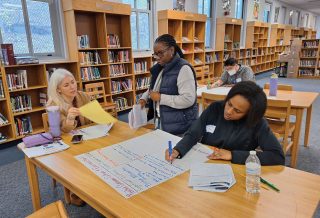FOCUS
Leading The Way In Literacy
Classroom visits offer a comprehensive view of teaching and learning
By Bonnie Houck and Sandi Novak
Categories: Data, Learning designsOctober 2017
Vol. 38 No 5
Read the remaining content with membership access. Join or log in below to continue.
Sed ut perspiciatis unde omnis iste natus error sit voluptatem accusantium doloremque laudantium, totam rem aperiam, eaque ipsa quae ab illo inventore veritatis et quasi architecto beatae vitae dicta sunt explicabo. Nemo enim ipsam voluptatem quia voluptas sit aspernatur aut odit aut fugit, sed quia consequuntur magni dolores eos qui ratione voluptatem sequi nesciunt. Neque porro quisquam est, qui dolorem ipsum quia dolor sit amet, consectetur, adipisci velit, sed quia non numquam eius modi tempora incidunt ut labore et dolore magnam aliquam quaerat voluptatem.
Bonnie Houck (houckreadz@gmail.com) is an education consultant, author, and professor. Sandi Novak (snovak9133@gmail.com) is an education consultant and author.
References
DuFour, R. & Mattos, M. (2013). How do principals really improve schools? Educational Leadership, 70(7), 34-40.
Houck, B. & Novak, S. (2016). Literacy unleashed: Fostering excellent reading instruction through classroom visits. Alexandria, VA: ASCD.
Learning Forward. (2011). Standards for Professional Learning. Oxford, OH: Author.
Mizell, H. (2009, February). Top performance requires that system leaders develop principals’ learning. The Learning System, 4(5), 2.
Spillane, J.P. (2006). Distributed leadership. San Francisco, CA: Jossey‐Bass.
Categories: Data, Learning designs
Recent Issues
NAVIGATING NEW ROLES
April 2025
Whether you’re new to your role or supporting others who are new,...
LEARNING DESIGNS
February 2025
How we learn influences what we learn. This issue shares essential...
BUILDING BRIDGES
December 2024
Students benefit when educators bridge the continuum of professional...
CURRICULUM-BASED PROFESSIONAL LEARNING
October 2024
High-quality curriculum requires skilled educators to put it into...












